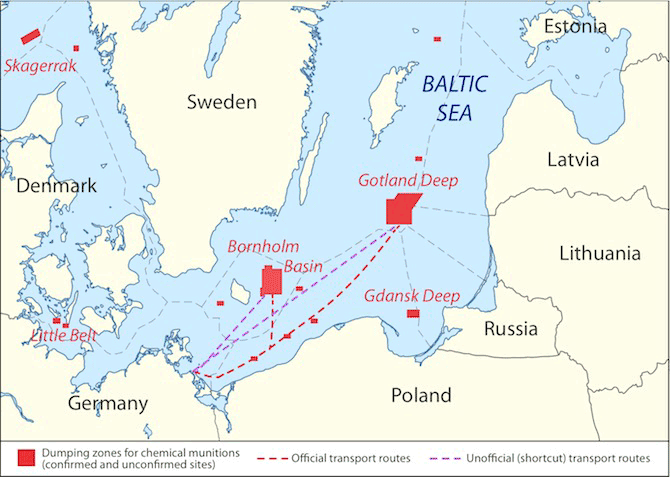After World War II nearly 300,000 tonnes of chemical weapons were removed from their storage site at Wolgast on the German territory and dumped, in their largest part, in the Baltic and North Seas. Official dumpsites are located near the island of Bornholm, in the Gotland basin, near the Little Belt in Denmark, and at the Skagerrak Strait. In most cases the warfare was thrown overboard, either loose (bombs, shells) or in containers, but some ships were also sunk.
Little Belt: At the southern entrance to Little Belt, German vessels loaded with nerve agent projectiles (tabun) and other types of chemical and conventional munitions were dumped at a water depth of about 30 m. Since the sea bed is covered with mud up to 8 m thick, the munitions are expected to have sunk into the sediment.
Bornholm Basin: Dumping east of Bornholm in the Bornholm basin was primarily inside a circular area with a radius of 3 nautical miles though the munitions are thought to have spread over a considerably larger area. Here, about 35,000 tonnes of chemical warfare were dumped in water depths ranging from 70 - 105 m. Also here a thick layer of mud (5 - 6 m) covers most of the bottom. The chemical weapons contained an estimated 13,000 tonnes of toxic agents, including mustard gas, Clark I and II, Adamsite and chloroacetophenone. Most were thrown overboard packed in crates or containers.
Gotland Deep: In the Southern Gotland Basin, southeast of the island of Gotland, at least 2,000 tonnes of chemical weapons (containing about 1,000 tonnes of chemical warfare agents) were dumped in water depths of 80 - 100 m. Most were thrown overboard. As is the case for the Bornholm site, the dumpsite boundaries in the Gotland basin remain uncertain, as chemical munitions likely spread over a larger area during dumping and later by fishing vessels when trawling.
Skagerrak Strait: in the Norwegian trench, at least 130,000 tonnes of chemical weapons were disposed of as well as close to 40 ships and vessels. In addition, off the Swedish coast near Maseskar, at least 9 vessels and about 20,000 tonnes of chemical munitions were dumped in water depths of around 200 m.
Recent information from the former GDR shows that in addition to the above-mentioned dumping areas, an area southwest of Bornholm might have also been used for dumping of chemical munitions. However, this information has not been verified.
During the cold war, munitions were also disposed of in an unofficial dumping site in the Gdansk Deep off the Polish coast.
There are also indications that part of the warfare was thrown overboard during transport to various dumpsites, though the amount is not known.

Multiple surveys and investigations have been carried out at these and other sites by several Baltic countries over the past decades. In order to compile all available knowledge, CHEMSEA carried out an inventory of all available data on the dumping sites. This included information available from various sources concerning location of dumped munitions, environment characteristics of the dumpsites, characteristics of the dumped munitions (e.g. corrosion status, CWA composition, extent of pollution) and any documentation of CWA shoring or fishing.
© CHEMSEA, IOPAN - wszelkie prawa zastrzeżone
Projekt i wykonanie - Virtual Services | Test zgodności W3C: HTML
Powered by: 